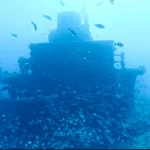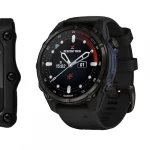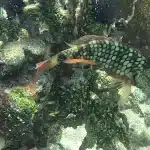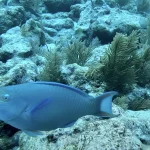Table of Contents
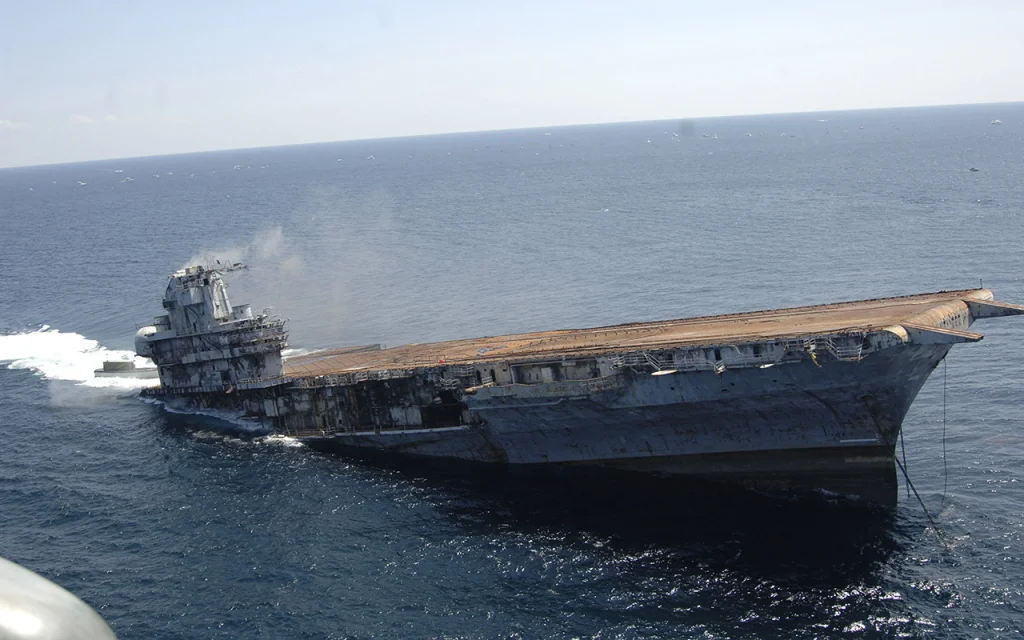
The USS Oriskany (CV/CVA-34) was an Essex-class aircraft carrier that served in the Korean and Vietnam Wars. After being decommissioned in 1976, it was eventually prepared to be sunk as an artificial reef off the coast of Pensacola, Florida in 2006.
Article at a Glance
• Location and Coordinates: The USS Oriskany artificial reef is located approximately 22-25 miles southeast of Pensacola Pass in the Gulf of Mexico, off the coast of Pensacola, Florida, with coordinates 30°02.555’N, 087°00.397’W.
• Diving Depth and Scale: The wreck sits upright on the seafloor at a depth of around 210 feet, with the control tower at 81 feet, the flight deck at 140 feet, and the bottom at 212 feet. The sheer size of the 911-foot long aircraft carrier is awe-inspiring and breathtaking.
• Marine Life: The Oriskany has become a thriving artificial reef ecosystem, teeming with marine life including small tropical fish, large predatory fish, pelagic species like whale sharks and manta rays, and even sharks. The biodiversity is unmatched by other wrecks.
• Navigation and Challenges: Divers must use the control tower as a reference point to navigate the massive wreck, and proper training, equipment, and gas management are crucial for this advanced wreck dive at serious depths. Air consumption and the urge to explore further are major challenges.
• Historical Significance: The Oriskany has a storied history of service in the Korean and Vietnam Wars, offering a rare opportunity to explore the interior of a massive warship. Its historical significance and marine biodiversity make it a unique and bucket-list-worthy dive experience.
• Safety Measures: Several safety measures are in place for divers visiting the USS Oriskany, including diver experience requirements, required equipment, depth limits and training, penetration restrictions, and general safety guidelines to ensure a safe and enjoyable dive.
• Dive Shops and Charters: Several dive shops and charters in the Destin and Pensacola regions offer diving trips to explore the USS Oriskany wreck, including technical diving charters that cater to experienced technical divers.
Reef Diving Depth and Coordinates
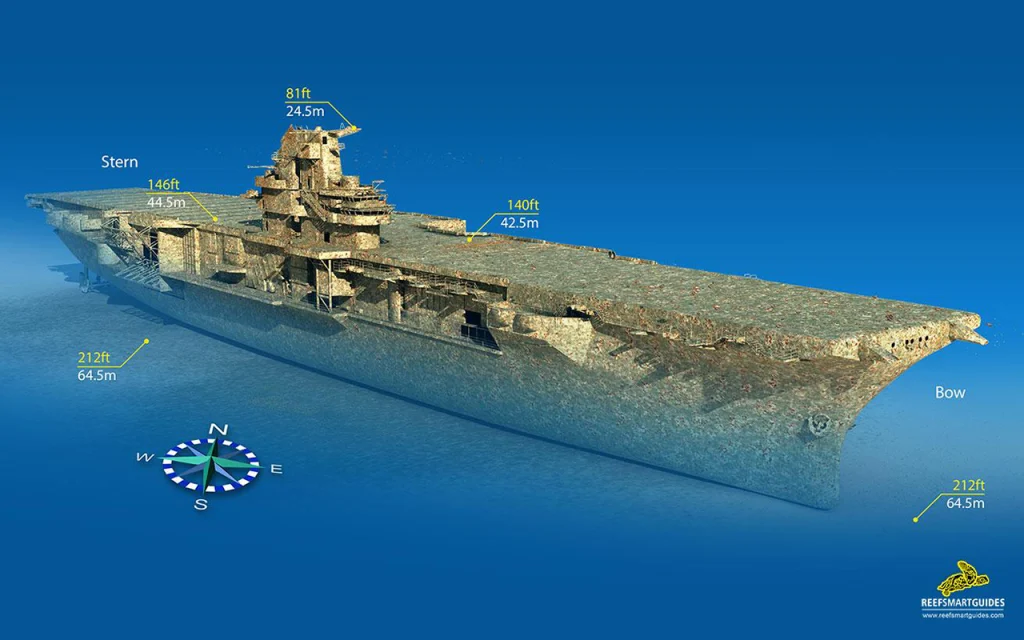
Diving Depth
- Tower 24.5 m (81ft)
- Deck 42.5m (140ft)
- Bottom 64.5m (212ft)
Location and Coordinates
- USS Oriskany artificial reef is located approximately 22-25 miles southeast of Pensacola Pass in the Gulf of Mexico, off the coast of Pensacola, Florida.
- 30°02.555’N, 087°00.397’W
What Scuba Divers Say About This Aircraft Carrier
Scuba divers who have explored the USS Oriskany artificial reef describe it as an awe-inspiring and massive wreck dive. Here are some of the key points they make:
Sheer Size and Scale
- Divers are struck by the immense size of the 911-foot long aircraft carrier, one of the largest shipwrecks in the world. The control tower alone is 62 feet tall.
- The flight deck spans over three football fields in length and sits at around 140 feet depth, beyond recreational limits.
- The sheer scale of the wreck is breathtaking and unforgettable when it materializes out of the blue water on descent.
Abundant Marine Life
- The Oriskany has become its own ecosystem, teeming with marine life including large pelagic species like whale sharks and manta rays.
- Bottom-dwelling reef fish populated the wreck immediately after sinking, and it didn’t take long for larger pelagics to arrive.
Navigating the Wreck
- Using the prominent control tower or “island” as a reference point is key to navigating the massive wreck.
- The good visibility, often 60-100 feet, helps with orientation but also tempts divers to exceed planned depths.
- Many recommend sticking to the superstructure area and not venturing too deep into the hull to avoid entanglement hazards.
Preparation and Challenges
- Proper training, equipment and gas management are crucial for this advanced wreck dive at serious depths.
- Air consumption is a major challenge, with the urge to explore further always present despite limits.
- Penetrating too deep into the hull risks silt-outs from exhaust bubbles and potential entrapment hazards.
What Kind of Marine Life Can Be Found on The USS Oriskany
The USS Oriskany has become a thriving artificial reef teeming with diverse marine life since it was intentionally sunk off the coast of Pensacola, Florida in 2006. Here are some of the key species that have made the wreck their home:
Tropical Reef Fish
- Small tropical fish like blennies, damselfish, and angelfish have proliferated on the wreck.
- These colorful reef fish inhabit the nooks and crannies of the superstructure and hull.
Large Game Fish
- The wreck attracts large predatory fish like snappers, groupers, and massive amberjack that hunt around the structure.
Pelagic Species
- Open water pelagic species like manta rays and whale sharks have been spotted cruising around the towering control tower or “island” of the carrier.
Sharks
- Various shark species including hammerheads, bull sharks, and even the massive whale shark are drawn to the Oriskany as an oasis of marine life.
Corals and Sponges
- Over 16 years underwater, living corals and sponges have grown extensively over the wreck, adding color and texture to the artificial reef.
The Oriskany has rapidly become an entire ecosystem, hosting everything from tiny reef tropicals to apex predators like sharks. This incredible diversity and abundance of marine life is a testament to the success of the wreck in providing crucial habitat, earning it nicknames like “The Great Carrier Reef”.
Key Information
| Category | Details |
|---|---|
| Ship Details | – Essex-class aircraft carrier that served in Korean and Vietnam Wars – Decommissioned in 1976, sunk as artificial reef off Pensacola, Florida in 2006 |
| Reef Diving Depth | – Tower: 81 ft (24.5 m) – Deck: 140 ft (42.5 m) – Bottom: 212 ft (64.5 m) |
| Location & Coordinates | – 22-25 miles southeast of Pensacola Pass, Gulf of Mexico – 30°02.555’N, 087°00.397’W |
| Size & Scale | – 911 feet long, one of the largest shipwrecks – Flight deck spans over 3 football fields – Control tower is 62 feet tall |
| Marine Life | – Teeming with reef fish, large pelagics like whale sharks & manta rays – Entire ecosystem from small tropicals to apex predators |
| Navigation | – Use control tower as reference point – Good 60-100 ft visibility but tempts exceeding depths |
| Preparation & Challenges | – Requires proper training, equipment & gas management – Air consumption & urge to explore further are challenges – Avoid penetrating hull to prevent silt-outs & entrapment |
| Safety Measures | – Diver experience & certification requirements – Alternate air source & surface marker required – Depth limits based on training – No interior penetration allowed – Follow general safety guidelines |
What Makes The USS Oriskany a Unique Diving Experience
Sheer Immense Size
- At 911 feet long and 145 feet wide, the Oriskany is an incredibly massive wreck, earning it nicknames like the “Mighty O” and “Great Carrier Reef”.
- The flight deck alone spans over three football fields in length, and the control tower stands 62 feet tall, dwarfing divers.
- Its towering profile and sheer enormity are breathtaking and unforgettable when the wreck materializes out of the blue water on descent.
Exploration of a Massive Warship
- As a decommissioned aircraft carrier, the Oriskany allows divers to explore the intricate details and rooms of an entire warship.
- Divers can swim through prepared openings, peer into the pilot house windows, circumnavigate the superstructure, and take in the scale of the flight deck.
- It offers a unique glimpse into naval history and the chance to experience the enormity of such a vessel up close.
Abundant Marine Life Ecosystem
- The wreck’s massive size has allowed it to become its own self-contained ecosystem, rapidly repopulated by marine life after sinking.
- Divers can encounter everything from small tropicals to large pelagics like whale sharks and manta rays cruising around the structure.
- The marine biodiversity inhabiting and surrounding the wreck is astounding.
Technical Diving Challenge
- With a maximum depth of 212 feet, the Oriskany presents a serious technical diving challenge requiring proper training and experience.
- Its size makes careful navigation, air consumption planning, and wreck protocols essential for divers to explore it safely.
The Oriskany’s status as one of the world’s largest diveable shipwrecks, combined with its historical significance as an aircraft carrier, marine biodiversity, and technical diving aspects, culminate in a truly bucket-list-worthy and awe-inspiring dive experience unmatched by most wrecks.
How Does The USS Oriskany Compare to Other Shipwrecks in Florida
Sheer Size
At 911 feet long and 212 feet deep, the Oriskany is by far the largest artificial reef wreck in Florida and one of the biggest in the world. Most other wrecks in the state are much smaller freighters, tugboats, or barges.
Historical Significance
As a decommissioned Essex-class aircraft carrier, the Oriskany has a storied history of service in the Korean and Vietnam Wars. It offers a rare opportunity to explore the interior of a massive warship. Other wrecks lack this historical context.
Marine Life
The Oriskany’s immense size has allowed it to rapidly become a thriving artificial reef ecosystem. Divers can encounter everything from small tropicals to large pelagic species like whale sharks and manta rays. The biodiversity is unmatched by other wrecks.
Depth and Technical Challenge
With a maximum depth of 212 feet, the Oriskany requires technical diving skills and experience to fully explore. Most other Florida wrecks are shallower and more accessible to recreational divers.
Popularity and Accessibility
Despite its depth, the Oriskany’s large size and proximity to Pensacola make it a very popular and frequently dived wreck. Its location on the edge of the Gulf Stream provides good visibility and conditions.
Full History of This Aircraft Carrier
Construction and Commissioning
- The name “Oriskany” was originally assigned to CV-18, but that hull was renamed Wasp when the keel was laid in 1942.
- CV-34 was laid down on May 1, 1944 by the New York Naval Shipyard, launched on October 13, 1945, and commissioned on September 25, 1950 after significant modernization.
- It was redesigned as the prototype for the SCB-27 modernization program, with a massively reinforced flight deck, stronger elevators, more powerful catapults, new arresting gear, and a rebuilt island structure.
Service History
1950-1956
- Departed New York in December 1950 for shakedown and training operations.
- Deployed to the Mediterranean with the 6th Fleet from May-October 1951.
- Transferred to the Pacific Fleet in 1952, arriving in San Diego in July.
- Deployed to Korea from October 1952 – February 1953, conducting bombing and strafing missions. Her pilots downed 2 MiG-15 jets.
1957-1968
- Underwent SCB-125A modernization from 1957-1959, receiving an angled flight deck and other upgrades.
- Made multiple deployments to the Western Pacific from 1960-1964, including operations off Vietnam in 1963.
- From 1965-1966, conducted over 12,000 combat sorties against enemy forces in Vietnam, earning a Navy Unit Commendation.
1968-1976
- Continued deployments to Vietnam through 1972, participating in major operations like Proud Deep in 1971.
- Suffered incidents like a collision with USS Nitro in 1972.
- Listed for inactivation in 1976 after her 15th deployment due to budget cuts and poor material condition.
Decommissioning and Reefing
- Decommissioned on September 30, 1976 and maintained as a mobilization asset until stricken in 1989.
- Plans to reactivate or donate her as a museum ship failed in the 1990s.
- Sold for scrap in 1995 but contract terminated in 1997 due to lack of progress.
- Approved in 2004 to become an artificial reef off Pensacola, Florida under a new law.
- Sunk by explosive charges on May 17, 2006 in 210 feet of water in the Gulf of Mexico, now known as the “Great Carrier Reef”.
What Historical Features Can Still Be Identified on USS Oriskany Wreck
Control Tower (“Island”)
The prominent control tower or “island” structure is largely intact and accessible to divers. It stands around 62 feet tall and rises to a depth of 84 feet. The tower is a major reference point for navigating the massive wreck.
Flight Deck
The expansive flight deck, spanning over three football fields in length, sits at a depth of around 145 feet. While beyond recreational diving limits, technical divers can explore the deck and catapult mechanisms.
Hangar Bay
The hangar bay, where aircraft were stored and maintained, is located at a depth of 175 feet. Divers can peer into the hangar through prepared openings in the hull.
Pilot House
The pilot house or bridge, where the ship was navigated, is located at a depth of 124 feet. Divers can look through the windows and see the interior of this historic space.
Superstructure
The wreck’s towering superstructure, including the various decks and compartments, is largely intact and provides a fascinating glimpse into the interior of an aircraft carrier.Divers can circumnavigate the superstructure and explore the details of this massive warship.
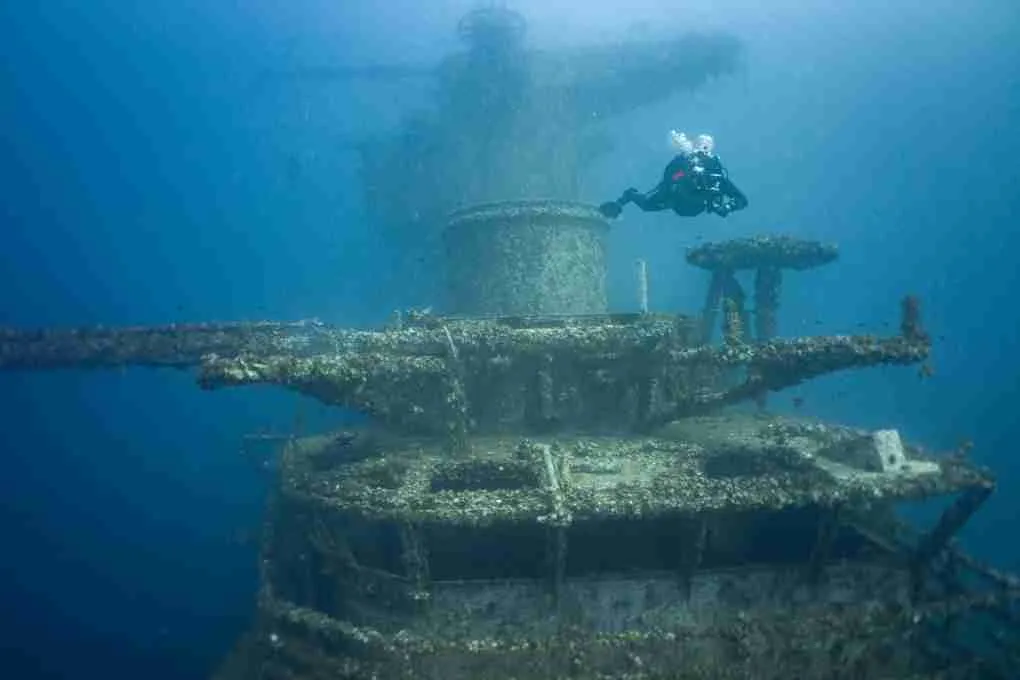
What Safety Measures Are in Place for Divers Visiting the USS Oriskany
Several safety measures and guidelines are in place for divers visiting the USS Oriskany artificial reef:
Diver Experience Requirements
- All divers must have a minimum of 20 logged dives to dive the Oriskany.
- Open water divers without advanced or deep certification must dive with a guide.
- Advanced or deep certified divers must have 2 recent dives below 80ft in the last year to dive without a guide.
Required Equipment
- Divers must have an alternate air source (octopus or redundant air system).
- Divers must carry a safety sausage or similar surface marker and whistle.
Depth Limits and Training
- The maximum depth is 212 feet, so technical training is required to go beyond 130-135 feet.
- The flight deck is at 140 feet, beyond recreational limits without advanced training.
- Divers should not exceed their certification level and plan dives based on the least experienced buddy.
Penetration Restrictions
- Divers should not enter or penetrate inside the ship due to unknown structural integrity and hazards.
- Removing any items from the ship is illegal.
General Safety Guidelines
- Plan dives carefully and don’t make plans too ambitious for the massive wreck.
- Use a descent/ascent line and stay aware of location relative to the boat’s anchor.
- Carry a surface signaling device in case of separation from the boat.
- Check marine forecasts and use safe boating practices.
- Remain with a buddy at all times and monitor air consumption closely.
The key emphasis is on proper training, experience, equipment, conservative dive planning, and avoiding penetration into the unstable interior of the wreck for the safety of divers exploring the Oriskany artificial reef.
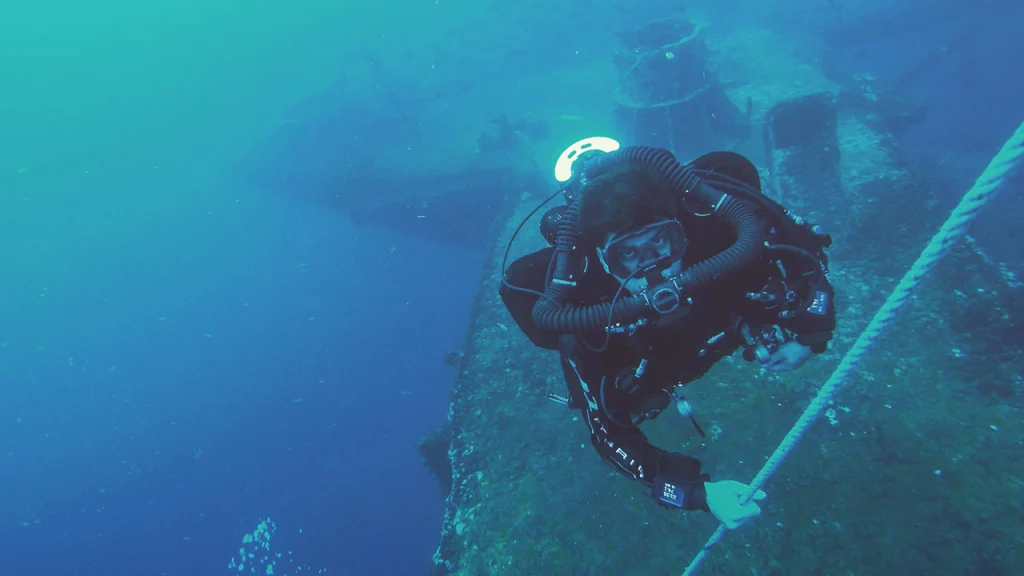
Dive Shops That Provide Diving Trips to This Ship
Here are some dive shops and charters that offer diving trips to explore the USS Oriskany shipwreck in the Gulf of Mexico:
- Reef Rokers Charters & Tours (Destin, FL)
- Narcossi Charters (Destin, FL)
- Dolphin Shuttle (Destin, FL)
These charters and tours based in Destin, Florida’s Emerald Coast region offer a variety of snorkeling, scuba diving, and fishing charters, including trips to explore the USS Oriskany wreck, which is a popular destination for recreational and technical divers.
In addition to dive shops, some charter fishing companies in Destin, Florida also offer trips to the USS Oriskany wreck, which is a large, accessible and intact shipwreck located approximately 70 miles southwest of Destin in the Gulf of Mexico.
While the companies, locations, and trip details vary, the USS Oriskany wreck is a major attraction for recreational, snorkeling, and fishing charters operating in the Destin, Pensacola, and Destin regions, due to the large size, intact structure, and abundant marine life surrounding the wreck.
Dive Shops That Specialize in Technical Diving on the USS Oriskany
There are a few dive shops and charters that specialize in or cater to technical diving on the USS Oriskany artificial reef:
Niuhi Dive Charters (Pensacola, FL)
- Specifically mentions accommodating technical divers to explore the lower decks, flight deck, and hull down to 212 feet on the Oriskany.
- Technical divers must provide a written dive plan and proof of certification level.
- The captain has experience with technical dives on the Oriskany to advise divers.
Trilogy Dive Center
- Offers dedicated “TecTrip” charter for technical diving on the USS Oriskany wreck.
- Requires Decompression Procedures or greater certification for these technical charters.
- Indicates it is for experienced technical divers going to depths of 145-225 feet on the wreck.
MBT Divers (Pensacola, FL)
- While not a technical dive operation itself, MBT notes that technical divers have found the Oriskany “more formidable than expected.”
- Warns that significant penetrations inside the wreck are difficult and risky without proper training.
- Provides historical information and a specialty course on diving the Oriskany safely.
Due to the massive size, depth range, and technical challenges of the Oriskany wreck, proper technical diving training, experience, and guided charters are recommended or required by the local operators in Pensacola. Recreational dive shops are aware of the wreck’s demands for technical divers.
North Florida Wrecks
- USS Oriskany
- USS Massachusetts
- SS Tarpon
- SS Gulf America
- Empire Mica
- USS Chippewa
- Avocet
- Black Bart
- The Vamar
- San Pablo
- USS Narcissus
- The Loftus Wreck
- The Dorothy Louise
- The Mizpah
- MV Janet
- The Eidsvag
- YDT-14 and YDT-15
- USS Strength
- Miss Louise
- The Lulu
- PC-1174
- Three Coal Barges
- USS Accokeek (ATA-181)
- El Dorado
- The Grey Ghost
- The Pete Tide II
- Red Sea Tug

